Nandina domestica
Looking to upgrade your garden with a durable evergreen shrub that provides year-round interest and doesn’t require the backbreaking labor of higher-maintenance plants, such as roses or hedges?
Look no further than heavenly bamboo.

We link to vendors to help you find relevant products. If you buy from one of our links, we may earn a commission.
A shrub with roots in Asian history, Nandina domestica is resistant to pests and disease, and is very adaptable to many different types of exposures.
It’ll do well in a variety of soil textures, and will visually change leaf shades in a kaleidoscopic manner as the seasons change. Its plumes of cream-white flowers and bright red berries are attractive in the landscape and to beautiful songbirds.
Save for the occasional pruning and fertilization, this plant is pretty hands-off, making it a valid candidate for the laissez-faire gardener.
Check out what’s ahead, folks:
What You’ll Learn
Before we dive in, a word of warning: N. domestica is considered invasive in much of the southeastern US.
Texas, South Carolina, Tennessee, Mississippi, Maryland, Louisiana, Kentucky, Arkansas, Florida, Georgia, Alabama, and Virginia have all classified the shrub as an invasive planting.
Before you plant, make sure to check your local laws.
Cultivation and History
Along with gunpowder, kites, and brain surgery, heavenly bamboo was first utilized by the Chinese. At the time of the Tang Dynasty, gardeners cultivated N. domestica as far back as the sixth century BCE.
From there, the plant was introduced to the Japanese in the 1600s, and has since been naturalized in central and southern regions of the country.
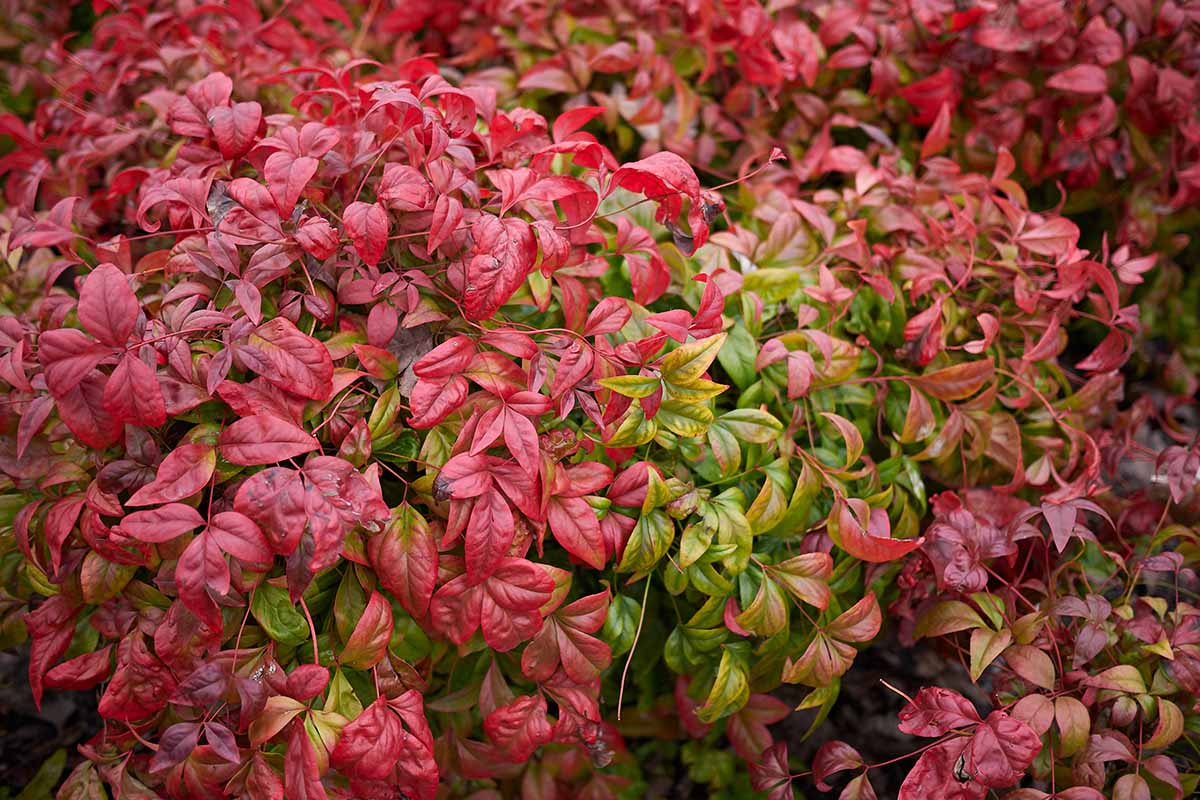
It was in the Land of the Rising Sun that heavenly bamboo was officially described and received its botanical name.
Nandina comes from the Japanese name Nan-Din, and domestica comes from the Japanese practice of planting this shrub near home entrances.
According to legend, sharing your bad dreams with the plant upon waking can relieve you of those hard-to-shake, post-nightmare heebie-jeebies.
N. domestica made its way to Europe in 1804, and was later brought to the New World.
Nowadays, it’s used as ornamental shrubbery, and the bamboo-like stems make for primo toothpick wood. In China, it’s also used for religious offerings and as decorations for Chinese New Year.
Despite its common name, this species is not technically a true bamboo. It’s a woody shrub, whereas actual bamboo species are large grasses.
Take care not to drop this fact too aggressively in conversation, though… you could be publicly diagnosed with severe plant nerdiness.
A note on heavenly bamboo berries and birds:
N. domestica berries contain cyanide, which is toxic to a variety of birds. After the submission of five dead cedar waxwings to the University of Georgia’s College of Veterinary Medicine in 2009, researchers deemed the cause of death to be ingestion of a large amount of N. domestica berries.
You can opt to not plant N. domestica for the sake of North American birds, if you wish. Alternatively, if you’re rather attached to your existing plantings you could prune away the fruiting branches of the shrub before or as they develop berries.
You could even utilize fruitless or essentially fruitless cultivars such as ’Nana,’ ’Gulf Stream,’ and ’Fire Power.’
Propagation
Heavenly bamboo can be propagated from seed, transplants, or from cuttings.
From Seed
To propagate N. domestica from seed, you’ll first need to acquire said seeds.
If you’d rather harvest your own, begin by picking the bright red berries in the fall. After a good overnight soaking, extract the seeds from the fruits and clean them off.
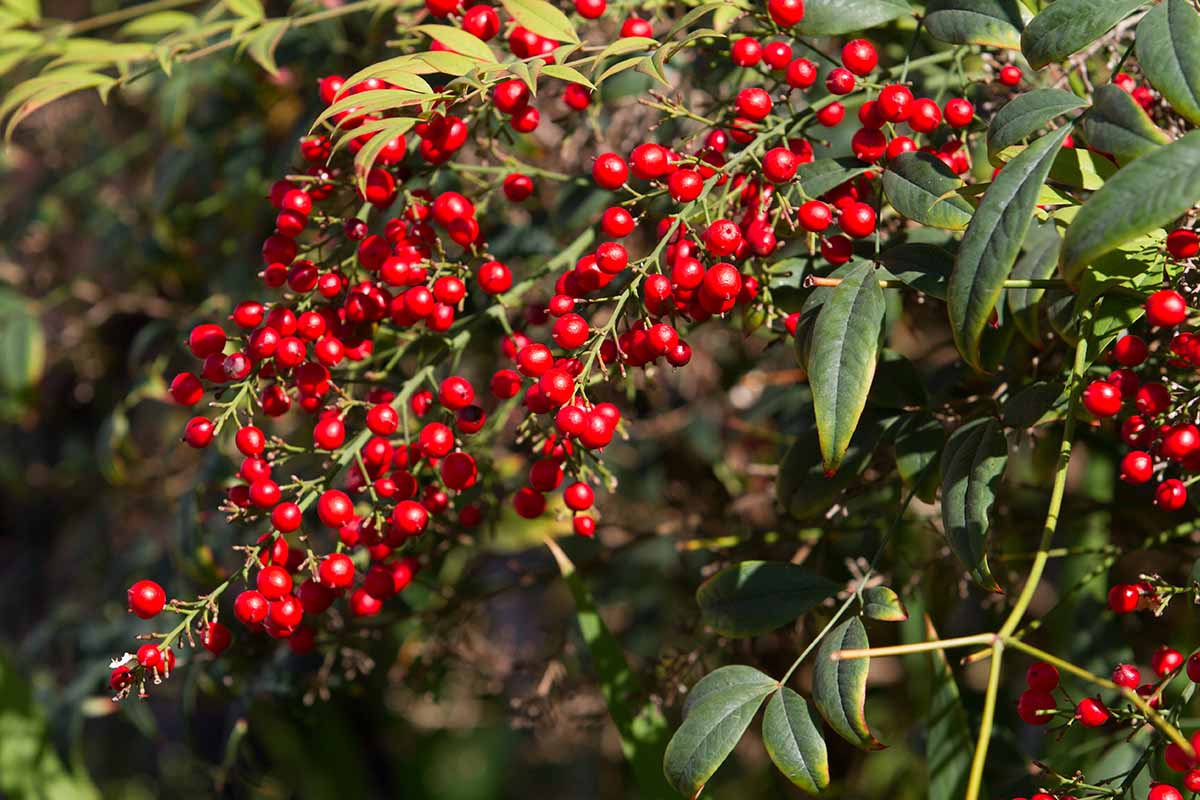
The berries are poisonous to humans and animals, so be sure to wear gloves and clean everything involved in the harvest afterwards.
Dry the seeds after harvest on screens. Store in a dry location with a temperature of about 40°F until the summer.
Come summertime, plant each seed three inches deep and two to three feet apart in the ground where you wish for them to grow.
Alternatively, you can plant the seeds in a seed tray of 50-50 sphagnum moss and perlite.
Keep the planting medium moist via misting until they germinate and develop into seedlings.
From Transplants
To transplant, simply prepare holes as deep as the roots or root ball and plant them two to three feet apart. You’ll then want to water regularly until the plant is established.
Heavenly bamboo transplants like a dream, which is excellent if you have homegrown seedlings or a transplant from an outside vendor.
Speaking of, you can purchase N. domestica transplants from Fast Growing Trees.
From Cuttings
Rooting cuttings is a great option if you want to utilize your preexisting N. domestica plants for propagation while bypassing that waiting period that comes with sowing seeds.
This method is typically less effective than propagating seeds or nursery transplants, but it can be rewarding nonetheless.
Shoots are the ideal plant parts to use here, whether they’re from the foliage or they’re sprouting laterally from the roots as adventitious shoots, also known as suckers.
Select your cuttings and remove them from the plant with a sterilized propagation knife.
To ensure success, dip the ends in a rooting compound formulation of 150 parts per million (ppm) Naphthalene acetic acid (NAA) mixed 2500 ppm indole-butyric acid (IBA), and wait until the cut end has callused over before planting.
These synthetic rooting hormones simulate the auxin that’s naturally found in plants and will stimulate root growth.
If you’re in need of the aforementioned rooting hormones, Hormex offers NAA hormone concentrate in four-, eight-, 16-, and 32-ounce bottles, available via Amazon.

You can find IBA powder in two-ounce bottles available from RootBoost via Amazon.

RootBoost Powdered Rooting Hormone
After wound encapsulation, prepare a tray or small pot with a 50-50 mix of sand and vermiculite.
Set the cuttings an inch deep in the mixture, and space them two inches apart. Then place the tray or pot in indirect sunlight and mist the cuttings daily until they form roots, which signifies that they’re ready for transplanting.
Root formation should take about six to eight weeks.
How to Grow
One of the cool things about heavenly bamboo is its ability to grow and withstand a variety of conditions, making it a very flexible addition to your garden.
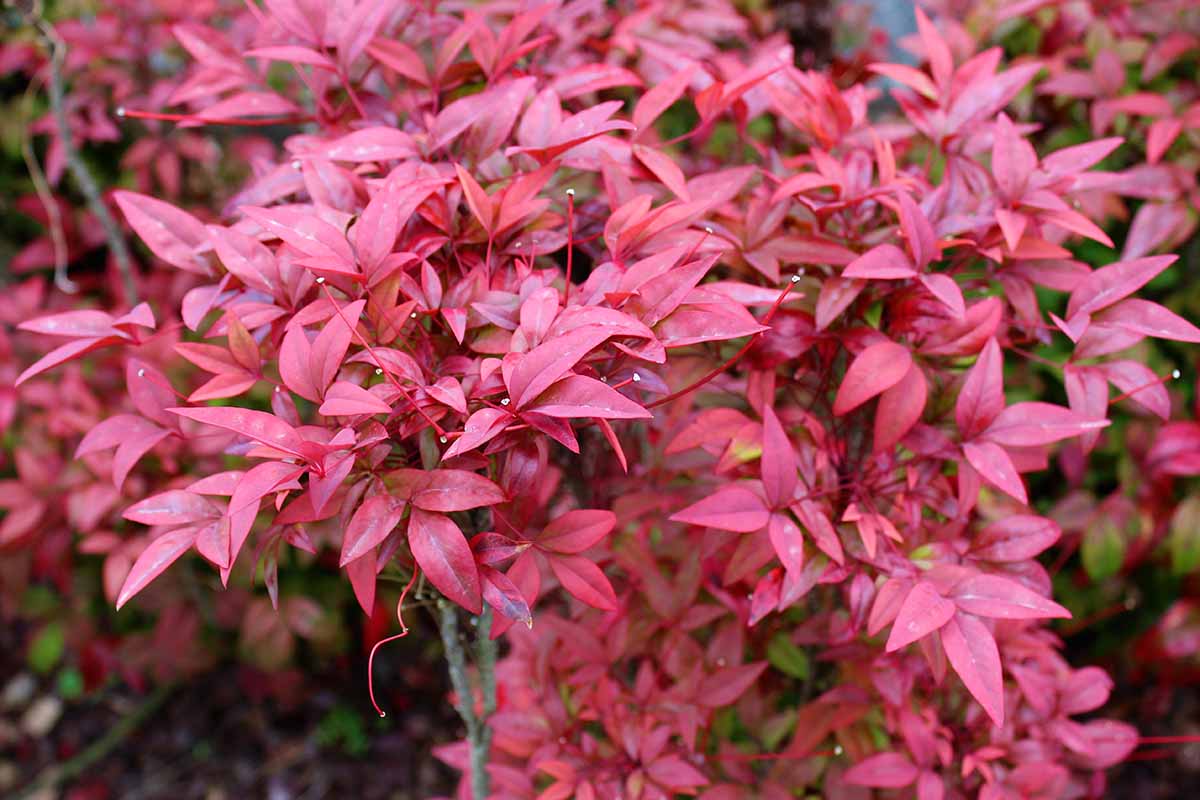
It grows so aggressively, in fact, that it can quickly naturalize unless care is taken to ensure it doesn’t take over your garden.
Climate and Soil Needs
N. domestica grows best in USDA Hardiness Zones 6 to 9. It prefers full sun or light shade, but can tolerate heavy shade.
Soil-wise, it tolerates a variety of textures, as long as it’s well-drained and fertile. That eliminates barren and/or clay soils, but the rest is fair game. Just make sure the pH falls in the range of 5.0 to 7.4.
Irrigation and Fertilizer Needs
Heavenly bamboo prefers that its soil is always kept moist for optimal growth and development… although it does tolerate drought once established.
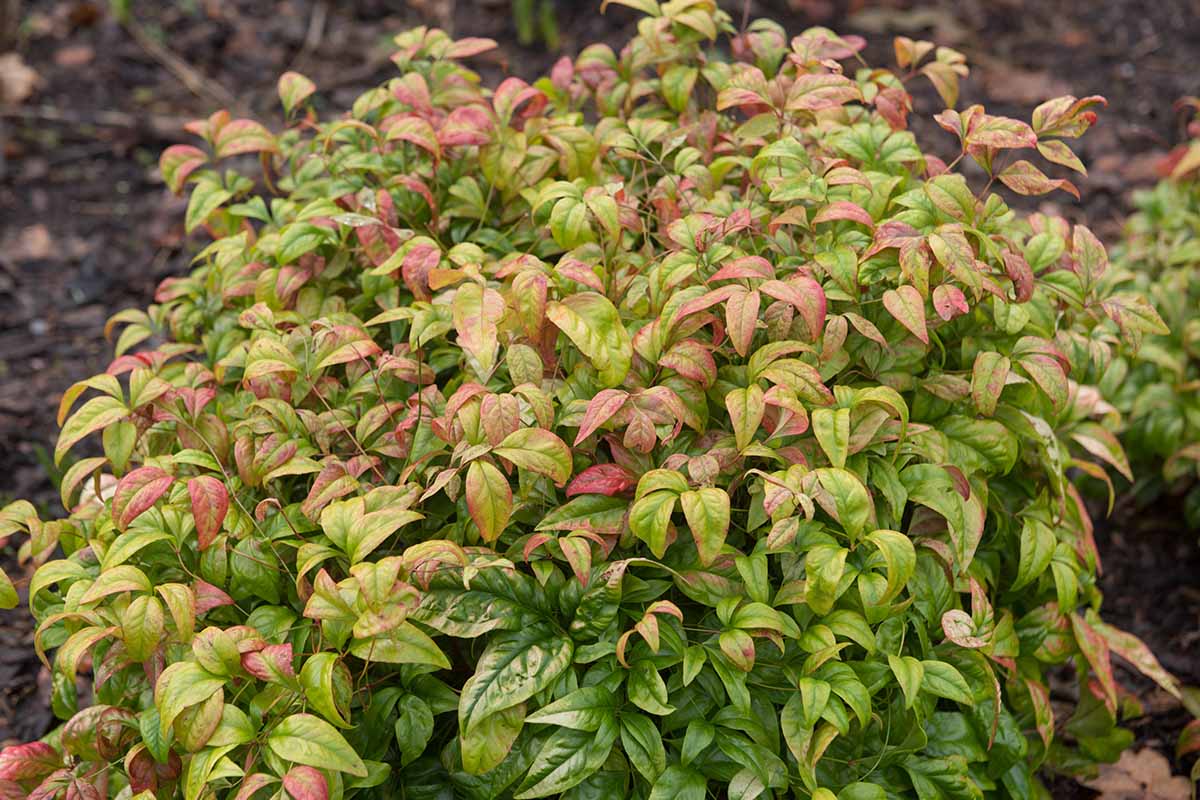
It’s ideal for enthusiastic waterers who haven’t mastered watering discipline as long as the area drains well, as this plant will take whatever water you throw at it, while also being very forgiving of neglectful hydration.
This plant likes it fertile, so amending the soil with organic material such as compost or manure will keep conditions optimal.
Work up to two inches of organic matter into the soil around your heavenly bamboo at the beginning of every growing season.
Growing Tips
- The evergreen leaves change to varying shades of red and green come wintertime, so keep in mind where these shrubs would stand out as holiday decorations!
- Keep in mind that the berries are mildly toxic. Ingestion is rarely fatal, but still not a good idea for you or your pets to consume.
- Heavenly bamboo is considered invasive in some regions, so consult your area’s invasive species lists and policies prior to planting.
Pruning and Maintenance
Like a senior citizen with severe GI distress, N. domestica could use a good prune every now and again.
Much of the aesthetic appeal of heavenly bamboo comes from its bamboo-esque woody stems, or canes, which can become leggy and weak if plants aren’t pruned every year.
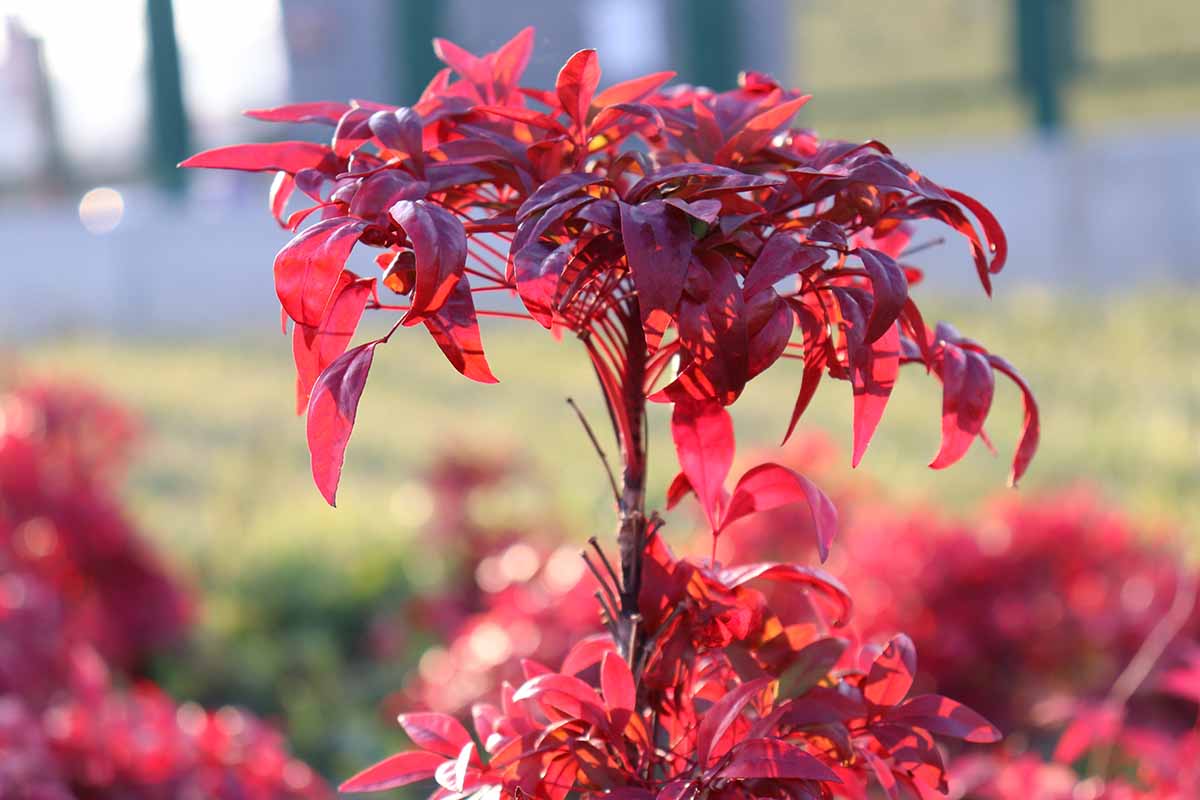
Pruning should be done in winter, when growth has ceased. Handheld pruners should do the trick for most of the stems, save for the oldest and thickest ones. Cutting those back will require some loppers.
Remove canes that make the shape of the plant look crowded and uncontrolled, as well as tall canes that stick out, all bare and exposed. Take them all the way to the ground, and don’t prune more than a third of the plant at once.
Shearing the foliage like you would with hedges takes away from this shrub’s natural floof, so avoid giving it a haircut if at all possible.
Cultivars to Select
The plain ol’ heavenly bamboo is a fantastic bit of flora, even when it’s just the standard N. domestica. But it also has a lot to offer via its cultivars. Let’s explore the top varieties!
Compacta
As its name implies, ‘Compacta’ is a smaller cultivar, reaching two to three feet in height instead of the standard six to eight.
Its foliage starts out red, becomes blue-green in the summer, then returns to a brilliant red come autumn and wintertime.
Despite its diminutive size, it retains the hardiness and adaptability of its larger predecessor, proving that bigger isn’t always better.
Want a ‘Compacta’ of your own? Nature Hills Nursery has what you’re looking for, in #1 or #5 containers.
Fire Power
A semi-evergreen cultivar with a two-foot height and width, ‘Fire Power’ has unique, thin foliage.
During the summer, its leaves take on a lime green hue. During fall semi-senescence, it features shades of orange to go with the usual fiery red of the standard species variety.
This non-fruiting cultivar assaults your eyeballs with a potent payload of visual interest, living up to its name.
Want to add some ‘Fire Power’ to your arsenal of shrubbery? Load up with what Fast Growing Trees has to offer.
Gulf Stream
‘Gulf Stream’ is yet another cultivar that’s smaller than your standard N. domestica, at three- to three-and-a-half feet tall and wide.
It possesses foliage color similar to that of ‘Fire Power,’ although its summertime leaves ain’t quite lime green.
However, this plant doesn’t sucker as much as other cultivars or the species plant, making it ideal for gardeners who want their heavenly bamboo to stay put.
Dreaming of the supreme color scheme of ‘Gulf Stream’? Fast Growing Trees can turn your dreams into reality.
Managing Pests and Disease
Believe it or not, N. domestica has few significant pest or disease issues. You can rest easy, knowing your heavenly bamboo plants are safe. A nice change of pace from susceptible plants, eh?
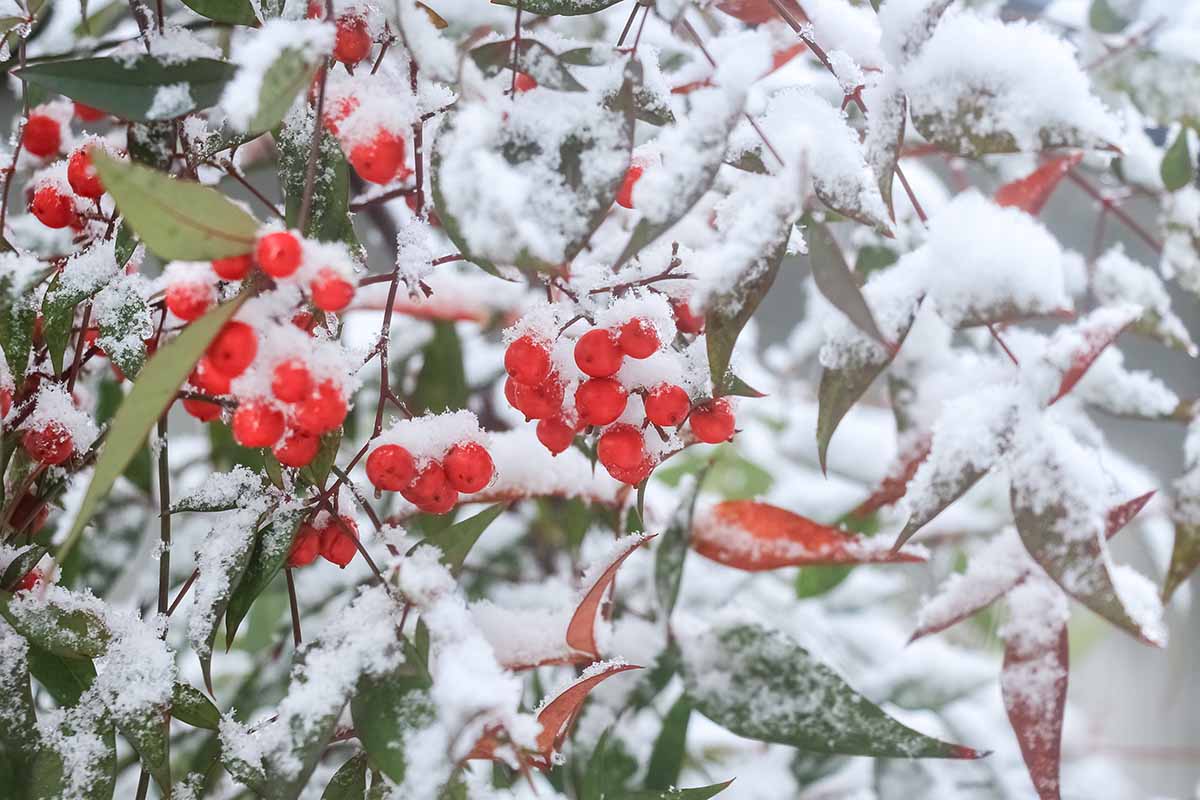
However, there are some potential issues for the gardening hypochondriac to be aware of, so let’s get into it.
Cottony Cushion Scale
Mature cottony cushion scale are tiny, orangish-brown-bodied insects that are coated with a white or yellow wax, and these will produce a massive fluted egg sac that increases the insect’s body length to a whole half inch.
These egg sacs are filled with up to 1,000 eggs, which hatch into red-bodied, black-legged crawlers. This results in large populations sucking phloem sap from the vegetative parts of heavenly bamboo, which can cause defoliation and dieback.
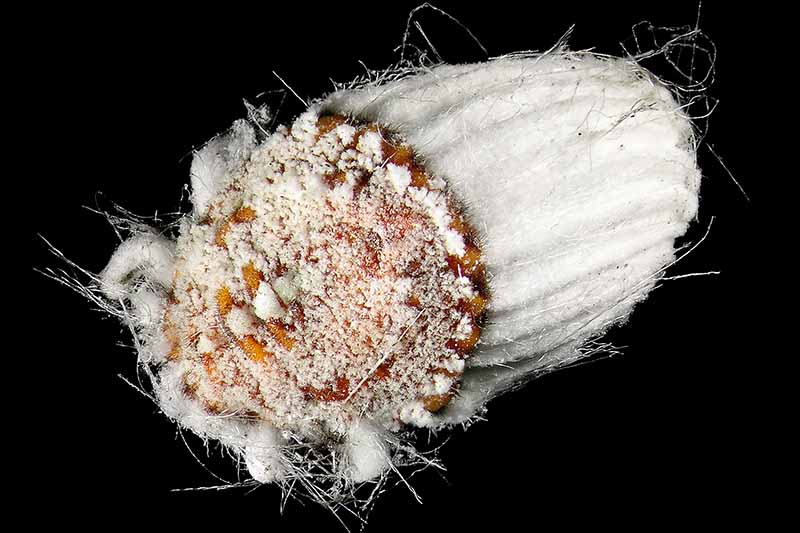
Control can be achieved by applying horticultural oil to the plants during the dormant season, or by spraying with an organic herbicide in the spring or fall.
However, the vedalia beetle (Novius cardinalis) and the parasitic fly Cryptochaetum iceryae are very effective means of biological control.
They’re so effective, in fact, that if these insects are found near your heavenly bamboo, hold off on resorting to any chemical measures. Let nature do a better job of controlling your cottony cushion scale infestation.
Powdery Mildew
Caused by the fungus Erysiphe berberidis, powdery mildew shows up on the topsides of heavenly bamboo leaves as a powdery clumps of white fungal growth.
Infected leaves are usually smaller, curled, and more reddish-looking than normal. Over time, the mildew can move from individual leaves to cover entire shoots.
Planting heavenly bamboo in full sun and providing adequate spacing between plantings for air circulation can help prevent the fungal growths from occurring.
Wiping infected leaves with a wet cloth can remove the mildew, and getting rid of fallen leaves can help prevent further disease spread.
Fungicides can be used in one-to-two week intervals before symptoms develop as another preventative measure.
Cucumber Mosaic Virus
In heavenly bamboo, cucumber mosaic virus causes wine-red discoloration in newly grown spring leaves, as well as narrowed leaves and downward leaf cupping. Plants that are infected also tend to produce fewer flower buds and berries.
There isn’t a cure or treatment available for this virus, so once an individual plant is infected, it must be culled in order to prevent further spread.
Buying virus-free heavenly bamboo is an effective preventative step, as is using sterile pruning and propagation tools.
Plantago Asiatica Mosaic Virus
Plantago asiatica mosaic virus results in a light red mosaic discoloration in infected plants, along with possible leaf distortion and stunting.
There isn’t a fix for this mosaic virus either, once infection takes place, so infected plants should be removed and replaced if their performance in the landscape isn’t up to snuff.
Only use sterilized tools in order to prevent further infection, as PAMV spreads primarily from diseased heavenly bamboo sap hitching a ride on contaminated gardening implements.
Best Uses
Heavenly bamboo looks fantastic as both a specimen plant or en masse. Its soft foliage serves as a nice contrast to harsher-textured shrubs in the landscape, and provides year-round visual interest.

Smaller cultivars may be used to accent larger plantings, while the larger varieties can be used to hide visually-obtrusive structures such as sheds, drainpipes, or AC units.
Quick Reference Growing Guide
| Plant Type: | Woody shrub | Flower / Foliage Color: | Cream-white flowers/blue-green foliage (dark red in fall) |
| Native to: | China, Japan | Maintenance | Moderate |
| Hardiness (USDA Zone): | 6-9 | Tolerance: | Soil and exposure extremes, drought, salt, deer |
| Bloom Time: | Late spring to early summer | Soil Type: | Fertile, rich in organic matter |
| Exposure: | Full sun to shade | Soil pH: | 5.0-7.4 |
| Spacing: | 2-3 feet | Soil Drainage: | Well-draining |
| Planting Depth: | 3 inches (seeds), root ball depth (transplants) | Attracts: | Small mammals, songbirds |
| Height: | 6-8 feet | Uses: | Specimen, mass plantings, eyesore camouflage |
| Spread: | 2-3 feet | Order: | Ranunculales |
| Water Needs: | Low | Family: | Berberidaceae |
| Growth Rate: | Moderate | Genus: | Nandina |
| Common Pests and Diseases: | Cottony cushion scale; powdery mildew, mosaic viruses | Species: | Domestica |
A Final Ballyhoo for Heavenly Bamboo
By now, I hope the majesty of N. domestica is not lost on y’all. Such a balance of aesthetic beauty and tough-as-nails hardiness is hard to find in a lowly garden shrub, but heavenly bamboo manages to pull it off.
Now that you know how to grow and care for it, feel free to enjoy all the resilience and visual flavor that this plant has to offer!

Have experience wrangling N. domestica? Got questions, concerns, or thoughts you’d like to share? Turn ‘em loose in the comments section below, I’d love to read and respond!
If heavenly bamboo tickled your fancy, take a look at these guides on evergreen shrubs next:
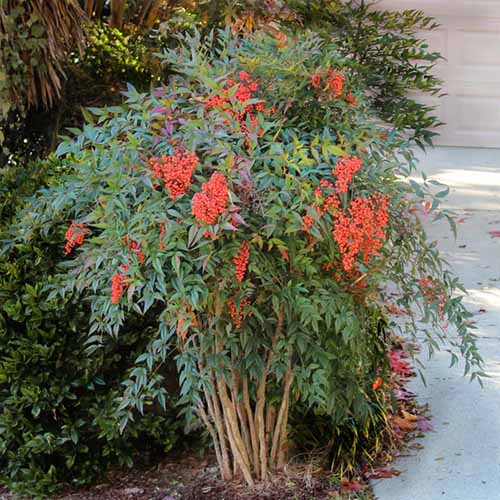

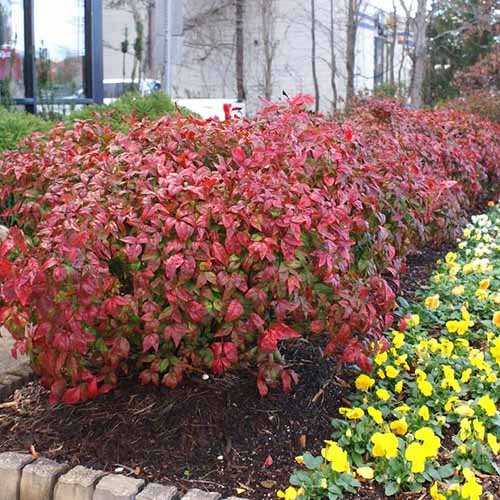
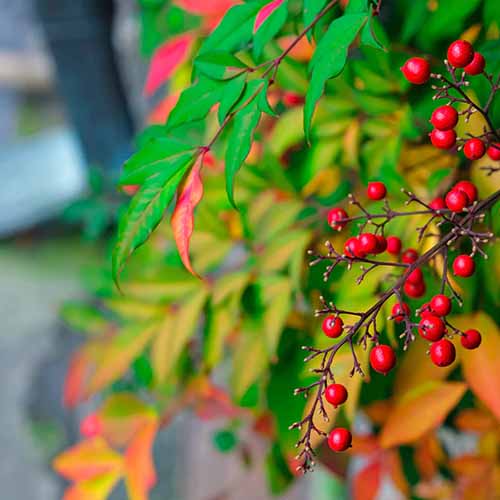
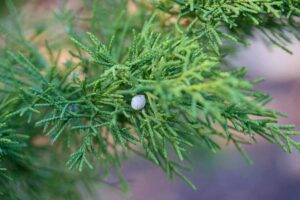
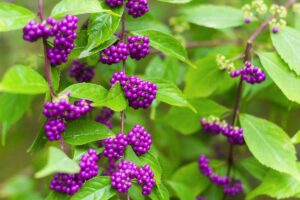

Nandina is well-known to kill native birds such as waxwings, and no one should plant it in North America.
Thank you for your insight, John! We’ll make the necessary changes in the guide for our North American readers ASAP.
Agree 100%. Nandina is destructive. It has no place in a garden.
NOOO. Just NO, NO, NO. This is a horrible, invasive plant that is one of the scourges of my community (bradford pear and English ivy are another two).
Please do NOT promote this plant. It does not belong in a garden in the United States. In addition to threatening biodiversity, it harms birds.
Please do an update post or remove this one. Also, watch Dr. Doug Tallamy (or read one of his books) to understand the importance of biodiversity and of our native plants. The way we garden directly impacts climate change and extinction rates. Please educate yourself.
“Like a senior citizen with severe GI distress, N. domestica could use a good prune every now and again.”
What a weird comment . . . how do you prune a senior citizen with severe GI distress?
Okay, now I get it . . . but, keep in mind, not only senior citizens are subject to GI problems.